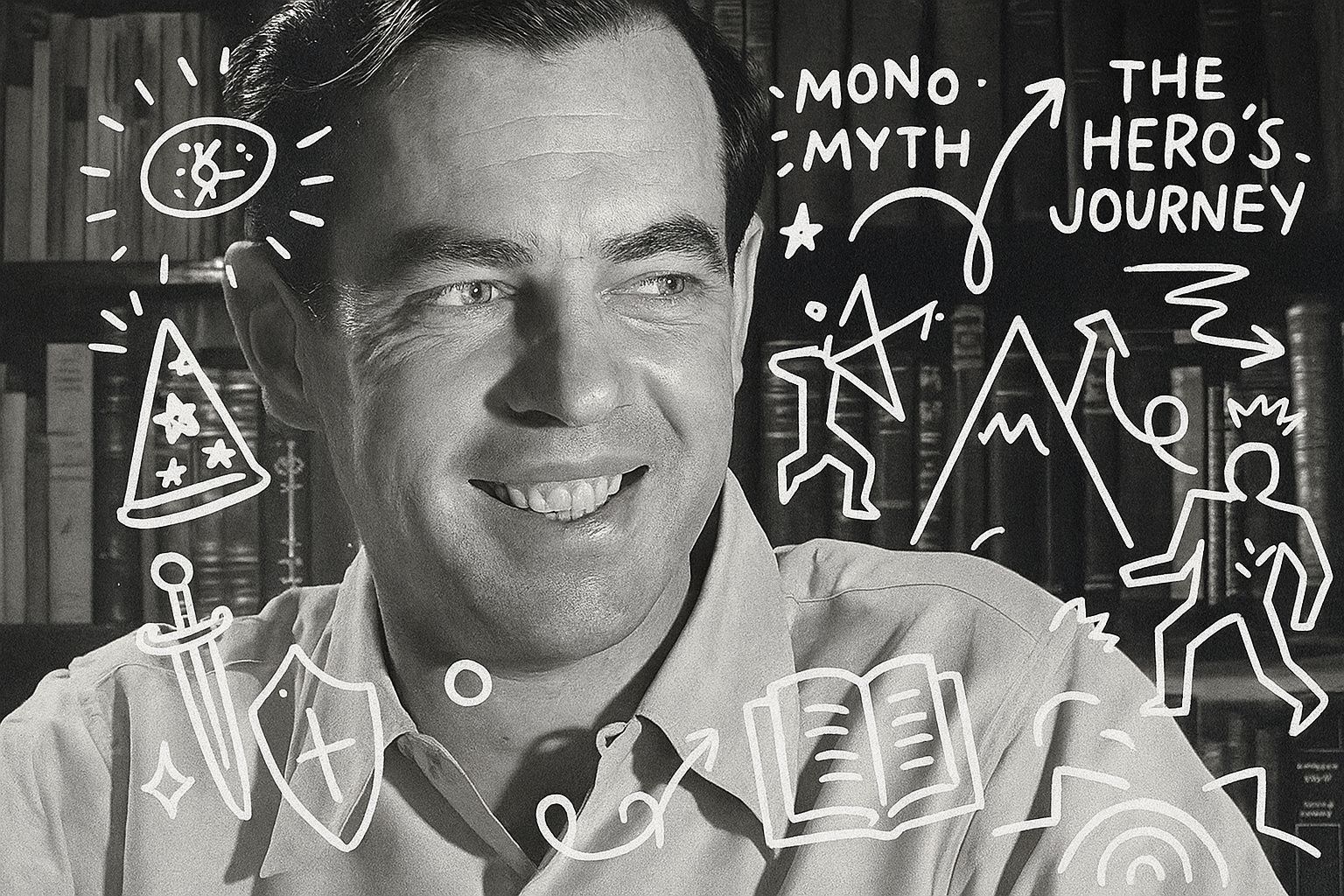- Beyond the Story by Epaphra
- Posts
- How One Book Broke Hollywood's Creative Code
How One Book Broke Hollywood's Creative Code

Hey Beyonder!
What do Star Wars, Harry Potter, The Matrix, and your favorite Marvel movie have in common?
They all follow the same ancient story pattern that Joseph Campbell discovered in his groundbreaking book "The Hero with a Thousand Faces."
Campbell studied thousands of myths, legends, and stories across every culture and found something incredible: Every powerful story follows the same basic structure.
He called it the Monomyth. Hollywood calls it the Hero's Journey.
Content creators should call it their secret weapon.

Meet Joseph Campbell, the man behind the famous ‘Hero’s Journey’
📖 The Book That Changed Everything
The Hero with a Thousand Faces, published in 1949, Campbell's research revealed that humans have been telling the same story for thousands of years, just with different characters and settings.
From ancient Greek myths to modern blockbusters, the pattern is always the same:
A hero ventures forth from their ordinary world into a realm of adventure, faces trials, gains wisdom, and returns transformed with the power to help others.
Why this matters for creators: This isn't just a story structure. It's the psychological blueprint of human transformation.
And transformation is exactly what your audience craves.

The OG Concept of The Hero's Journey
The Hero's Journey: Campbell's 17 Stages (Simplified for Creators)
Campbell originally outlined 17 stages, but for content creators, we can distill this into 3 Acts with 4 key stages each:
ACT I: THE DEPARTURE
1. The Ordinary World
Where the hero starts (comfortable but unfulfilled)
Content application: Your audience's current reality
2. The Call to Adventure
Something disrupts their normal life
Content application: The problem or opportunity you're addressing
3. Refusal of the Call
Initial resistance or fear
Content application: The doubts and objections your audience has
4. Meeting the Mentor
Guidance appears to help them begin
Content application: This is where YOU enter as their guide
ACT II: THE INITIATION
5. Crossing the Threshold
Committing to the journey despite fear
Content application: Your audience taking the first step
6. Tests, Allies, and Enemies
Facing challenges and discovering who helps/hinders
Content application: The obstacles they'll encounter and overcome
7. The Ordeal
The biggest fear or most difficult challenge
Content application: The moment of truth/breakthrough
8. The Reward
Surviving death and gaining something powerful
Content application: The transformation or result they achieve
ACT III: THE RETURN
9. The Road Back
Deciding to return and share the wisdom
Content application: Integrating the change into real life
10. Resurrection
Final test and transformation
Content application: Becoming someone who helps others
11. Return with the Elixir
Coming home with power to heal the ordinary world
Content application: Your audience becoming the mentor for others

How Star Wars Used Campbell's Blueprint
George Lucas literally used Campbell's book as his guide when writing Star Wars. Here's the direct mapping:
Luke's Journey:
Ordinary World: Farm boy on Tatooine
Call to Adventure: Princess Leia's message
Refusal: "I can't get involved"
Mentor: Obi-Wan Kenobi appears
Threshold: Leaving Tatooine
Tests: Cantina, Death Star, storm troopers
Ordeal: Rescuing Leia, Death Star trench run
Reward: Destroying Death Star, becoming a hero
Road Back: Continuing to fight the Empire
Resurrection: Confronting Vader and the Emperor
Elixir: Bringing balance to the Force
The result? The most successful movie franchise in history, because it tapped into a story pattern our brains are wired to love.
The Hero's Journey for Content Creators
Your Audience is the Hero (Not You)
Biggest mistake creators make: Positioning themselves as the hero of every story.
Campbell's wisdom: The audience must be the hero.
You are the mentor - Obi-Wan, not Luke.
How to apply this:
Wrong: "Here's how I built my business"
Right: "Here's how you can build your business (like I did)"
Every Piece of Content Can Be a Mini-Journey
You don't need an epic saga. Even a simple Instagram post can follow the hero's journey:
Instagram Reel Example:
Ordinary World: "You post daily but get no engagement"
Call: "What if I told you one change could fix this?"
Refusal: "You probably think it's impossible"
Mentor: "I discovered this technique..."
Threshold: "Try this on your next post"
Test: "Watch what happens to your comments"
Reward: "Engagement that actually converts"
The 4 Types of Content Using Campbell's Framework
1. Origin Story Content
Your personal hero's journey that established your expertise.
Template:
Ordinary world: Where you started
Call: What forced you to change
Mentor: Who or what guided you
Trials: What you overcame
Return: How you now help others
2. Client Transformation Content
Someone else's hero's journey with you as mentor.
Template:
Their ordinary world (before working with you)
Their call to adventure (why they sought help)
The process (your methodology)
Their transformation (results achieved)
Their return (how they now help others)
3. Educational Content
Teaching your audience to navigate their own journey.
Template:
Current state (ordinary world)
Why change is needed (call)
Common resistance points (refusal)
Your framework (mentor guidance)
Expected challenges (tests)
Potential outcomes (reward)
This Week's Hero's Journey Challenge

Identify your transformation story (personal or professional)
Map it to the hero's journey stages above
Create one piece of content using this structure
Post it and tag it with #Beyonder’sMyHeroJourney
Reply with your "call to adventure" moment, I read every response and will share the most powerful transformations!
Remember: You're not just sharing a story. You're creating a myth that others can follow.
Keep telling Stories,
Epaphra
P.S. Campbell spent his life studying why certain stories endure for thousands of years while others are forgotten in days.